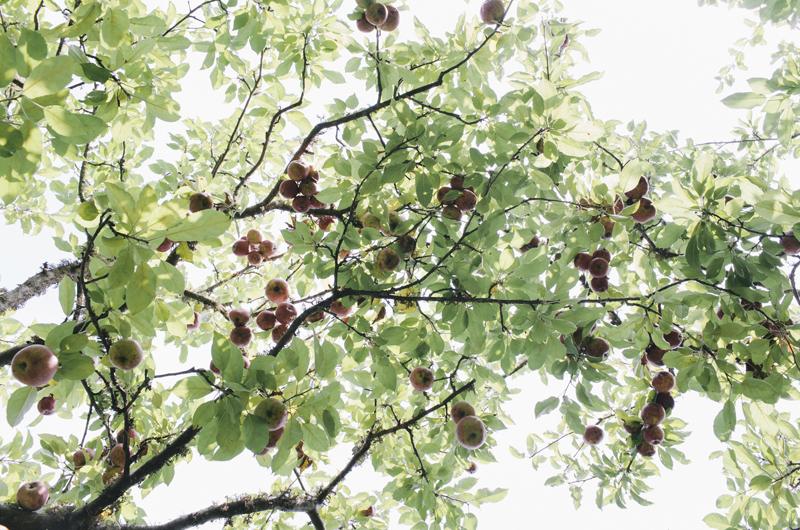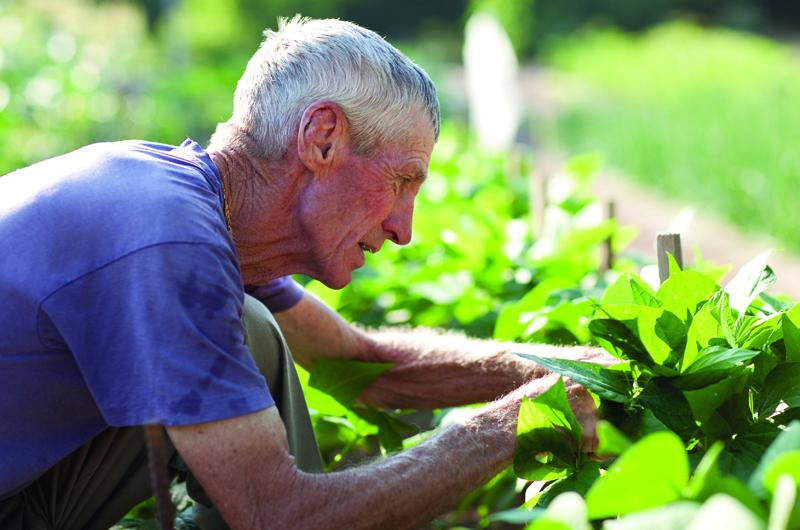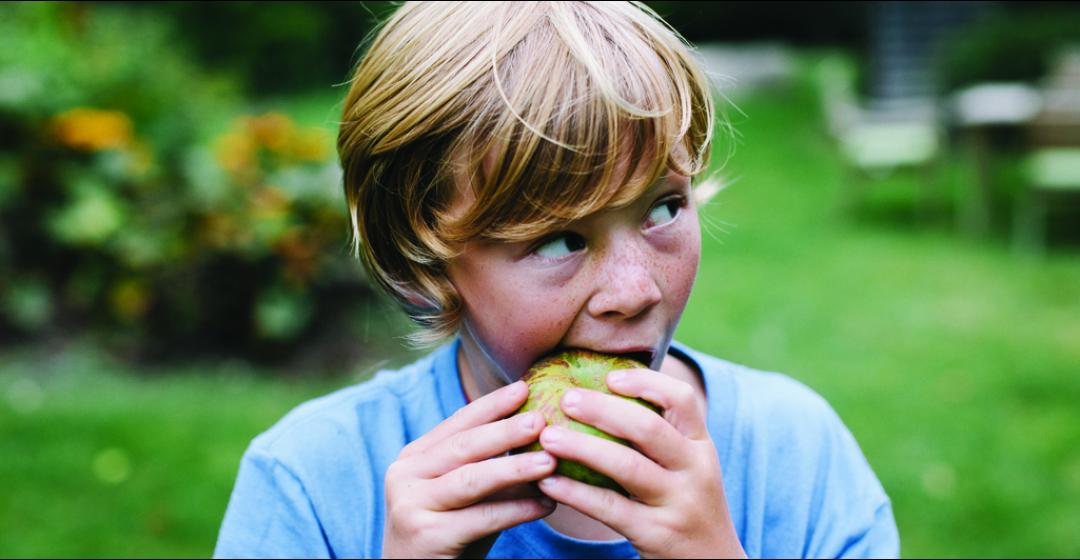Martha’s Vineyard is not particularly hospitable when it comes to fruit trees.
In fact, it’s “probably one of the worst places to grow fruit,” says arborist Josh Scott of Chilmark. Since starting Beetlebung Tree Care in 1993, Josh has experienced both the frustrations and the delicious rewards of trying. The odds of achieving the latter are greatly enhanced by knowledgeable plant selection, pruning, trial and error, and just plain luck.
He says the best way to grow an orchard here is to start with disease-resistant trees, planted in optimal growing conditions. For apples, Josh prefers Enterprise, Honeycrisp, and Liberty; for peaches, he likes Redhaven. Fruit trees need well-drained soil, exposure to breezes, and at least six hours a day of full sun.
Climate and weather play an integral role, he says, noting that while 2012 was a decent year for fruit trees since it was so dry, “this year hasn’t been as good, because the spring was wet off and on.” Encouraged by dampness, fungal diseases start on the foliage and spread to the fruit. It only takes twelve hours of moisture for fungal spores to incubate. “Fog, mist, and dew are the worst, not rain,” Josh says. “The spores open up and get airborne.”
He concentrates on organic practices whenever possible, using synthetic pesticides only in special situations, such as in the case of older trees vulnerable to structural damage from a fungus attack, or for clients who want to harvest store-quality fruit from their trees. Timing these treatments around bouts of dampness limits their application. “People like to know what we’re spraying on food,” Josh says. Some of the products in his organic arsenal include Bordeaux mixture, a combination of copper sulfate, hydrated lime, and dormant oil used as a fungicidal and insecticidal spray; neem oil, an insecticide/fungicide made from the seeds of the neem tree, Azadirachta indica; and Bt, Bacillus thuringiensis, an insect-killing microbe.

Less-than-perfect fruit is fine for home growers but not for the grocery store. Growing organic fruit is more complicated and can be more expensive than using conventional pesticides. It’s also quite a challenge in a wet climate like New England’s. That’s why most orchards in the Northeast are not organic, Josh says, and why much of the region’s organic produce is used for cider, juice, and applesauce – products in which blemished skin isn’t a problem.
Critters from mice to deer are attracted to the bark, buds, twigs, roots, and fruit. Vinyl-coated wire tree guards can keep the smaller animals away. Tall fencing is the best protection against deer. Aside from feeding on the trees, deer can severely damage bark with their antlers. Netting can help keep birds out. Josh had one client with a beautiful peach orchard, just ready for picking, only to discover one morning that raccoons had devastated the harvest overnight.
And then there are the insect troubles. The plum curculio weevil, Conotrachelus nenuphar, damages cherries, nectarines, pears, quince, plums, and especially peaches, by laying larvae in the fruit. Josh says the North Tisbury area of West Tisbusry has a concentrated infestation of plum curculio that he hasn’t seen around the rest of the Island. “If insects are happy because they have plenty to eat, they don’t need to travel.”
Home orchards don’t need to be large since the fruit from one healthy tree can satisfy the appetite of the average family, although some trees require a different variety nearby for cross-pollination, which occurs with the help of honeybees, wind, or birds. Planting a crab apple tree can help too; it blooms earlier than most other fruit trees and attracts bees for pollinating.
Josh says sometimes all you have to do is use tree guards and keep the structure of the trees sound by pruning. “I would never discourage someone from buying fruit trees; just buy inexpensive trees,” he explains. “It’s all about getting the right varieties.”
One Island orchardist took the philosophy of inexpensive trees to an extreme. Philippe Jordi, who oversees the orchard at Island Cohousing in West Tisbury, says most of the trees were procured about twelve years ago through a newspaper ad. “Somebody wanted to make room for a horse barn,” he recalls, so Philippe dug up the free trees and replanted them. Currently the orchard consists of Asian and European pears, peaches, apples, plums, and cherries.
Philippe prunes the trees every year, but he doesn’t apply chemicals. He says the Asian and European pears are really the only ones that produce. There are sixteen households and about half take advantage of the orchard. “It’s very informal – people pick and eat – there’s no formal harvest or distribution,” he says.
Paul Jackson of Edgartown is serious about gardening. He’s famous for the blue ribbons he wins every year at the Martha’s Vineyard Agricultural Society Livestock Show and Fair with the bounty from his garden. This past summer, he won a special state award for “most outstanding fruit” with his entry, which included apples, grapes, pears, and peaches.
Paul has at least three dozen fruit trees scattered around his property, with Empire apples taking up the most space. He uses them for pies, juice, and applesauce.
He says he’s tried organic sprays without much success, so he uses traditional pesticides. He starts with a dormant spray in early spring when the buds start to move, then switches to a general-purpose spray when buds begin to open, and keeps spraying about every two weeks through the fall.

Fruit trees are not meant to be shade trees, and pruning is an annual task for Paul. Removing branches helps stabilize the tree, and allows air circulation and sun penetration. “You prune to open it up and let the sun go right down inside,” he says.
His Asian pear trees were so laden with heavy fruit this fall that he rigged a series of supports for the branches out of lawn chairs, plastic crates, towels, old rugs, and wooden poles. Some of the pears weighed as much as a pound.
Paul doesn’t have a favorite, but he looks for the Giant Asian pear varieties and buys the deluxe quality. “You pay a little more, but you get a lot better tree,” he explains. He’s bought “special offer” trees before and they didn’t grow. Paul deals with underperforming trees by grafting a small piece of a successful variety onto the tree.
His peaches didn’t fare as well as the pears. “They have some type of fungus,” he says. “They start to get ripe and all of a sudden they rot.”
Paul raises crab apples for more than just their ability to attract bees. He makes jams and jellies using crab apple juice as a gelling agent and gets about ten quarts of juice from one mature tree. (Author’s note: While most of the fruit Paul gave me to sample was quite tasty, he tricked me into a bite of crab apple – yikes, bitter! – but the flavor is muted in the juice.)
He’s found that metal pie plates tied to stakes make enough noise that deer seem unsure of them and leave his garden alone. (For more deer-deterring tricks, see page 19.)
Success with fruit trees is all up to the gardener, he says, because you can’t just put them in the ground and walk away. “They start out as nothing but a stick, and you have to prepare the ground and then take care of them. I’m always in the garden looking for bugs, and things that don’t act right or look right.” Given his track record at the Ag Fair and the heft of his Asian pears, his eye for the little details has served him in good stead.
Helpful Resources
Online
The website for the University of Massachusetts–Amherst Center for Agriculture, www.extension.umass.edu/fruitadvisor, has information for the home orchardist, including advice on diagnosing plant problems, soil testing instructions, and weather and pest monitoring information. They also publish online newsletters called Healthy Fruit and Fruit Notes, and conduct workshops throughout the year.
Books
Josh recommends two books by New Hampshire author and apple expert Michael Phillips, who describes his natural approach to orchard management in The Holistic Orchard: Tree Fruits and Berries the Biological Way (Chelsea Green Publishing, 2012) and The Apple Grower: A Guide for the Organic Orchardist (Chelsea Green Publishing, 2005).
Nurseries
The following on-Island garden centers stock fruit trees, and most can special order a particular variety: Donaroma’s Nursery and Landscape Services, 270 Upper Main Street, Edgartown, 508-627-3036, www.donaromas.com
Heather Gardens, 377 State Road, West Tisbury, 508-693-1467, www.heather-gardens.com
Jardin Mahoney’s Garden Center, 45 Edgartown–Vineyard Haven Road, Oak Bluffs, 508-693-3511, www.jardinmahoney.com
Middletown Nursery, 680 State Road, West Tisbury, 508-696-7600, www.middletownnursery.com
SBS The Grain Store, 480 State Road, Vineyard Haven, 508-696-7271
Vineyard Gardens, 484 State Road, West Tisbury, 508-693-8511, www.vineyardgardens.net
Off-Island, Josh uses Adams County Nursery (www.acnursery.com) in Aspers, Pennsylvania, for their high-quality, disease-resistant stock. A wholesale company, they accept minimum orders of 25 trees, but will ship direct. Josh will often combine clients’ orders to reach the minimum. Adams also sells tree guards and soap bags that act as deer deterrents.
Paul purchases fruit trees from Stark Bro’s Nurseries and Orchard Company (www.starkbros.com) in Louisiana, Missouri, and buys insecticidal and fungicidal Dormant/All Season Spray Oil and Complete Fruit Tree Spray from Miller Nurseries (www.millernurseries.com) in Canandaigua, New York.





